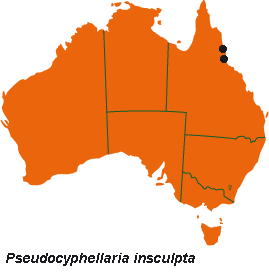



Australian Biological Resources Study
| Checklist of the Lichens of Australia and its Island Territories | ||
| Introduction | A–D | E–O | P–R | S–Z | Oceanic Islands | References | ||
| Pseudocyphellaria insculpta (Stizenb.) D.J.Galloway | ||
| Lichenologist 17: 305 (1985). Stictina insculpta Stizenb., Flora 81: 129 (1895); Stictina impressula Müll.Arg., Flora 71: 22 (1888) non. Nyl. [in Flora 57: 71 (1874), based on Stictina tomentosa var. impressula Nyl., Ann. Sci. Nat. Bot., sér. 5, 7: 305 (1867) from South America]; Sticta insculpta (Stizenb.) Zahlbr., Cat. Lich. Univ. 3: 388 (1925). T: Mt Bellenden Ker, Qld, 1887, W.A.Sayer; holo: G 0020099. ***** Stictina impressula var. sublaevis Müll.Arg., Hedwigia 30: 48 (1891); Stictina insculpta var. sublaevis (Müll.Arg.) Stizenb., Flora 81: 129 (1895); Sticta insculpta var. sublaevis (Müll.Arg.) Zahlbr., Cat. Lich. Univ. 3: 388 (1925). T: Bellenden Ker district, Qld, 1889, F.M.Bailey 575 p.p.; holo: G 002105. | ||
| Thallus rosette-forming to irregularly spreading in entangled clones, loosely attached centrally, 5–12 (–20) cm wide. Lobes irregularly divided, subdichotomously branching at apices to complex-imbricate centrally, 0.5–1 (–4) cm long, 1–4 (–8) mm wide; lobe margins irregularly notched or incised, occasionally densely isidiate or lobular-phyllidiate. Upper surface olive-grey suffused brownish when dry, vivid navy-blue to blue-black when wet, irregularly undulate, conspicuously dimpled, punctate-impressed, rather fragile and papery when dry, isidiate-phyllidiate, maculate, without pseudocyphellae or soredia. Maculae minute, white, effigurate to ±reticulate (×10 lens). Isidia at first terete to subgranular, becoming flattened-phyllidiate. Phyllidia mainly marginal, simple to coralloid, to 2 mm tall. Medulla white. Photobiont Nostoc. Lower surface pale yellow-brown or whitish and glabrous at margins, grey- to brown-black-tomentose centrally. Pseudocyphellae prominent, white. Apothecia rare, sessile, 1–2.5 mm diam.; disc red-brown, matt, epruinose; exciple pale pinkish brown, wrinkled-striate, occasionally white-tomentose below; epithecium pale yellow-brown; hymenium colourless; hypothecium opaque yellow-brown. Ascospores ellipsoidal-fusiform, 1–3-septate, 28–33.5 × 6.5–8.5 µm, yellow-brown to red-brown. CHEMISTRY: Methyl gyrophorate, gyrophoric acid, 7β-acetoxyhopane-22-ol, hopane-7β,22-diol (trace) and hopane-15α,22-diol. |  |
|
| Occurs in north-eastern Qld, on bark of trees and shrubs, on rotting logs and rocks in lowland to montane rainforest. Also known in the Palaeotropics from Sri Lanka to Fiji. | ||
| Galloway et al. (2001) | ||
| Checklist Index |
| Introduction | A–D | E–O | P–R | S–Z | Oceanic Islands | References |
This work is copyright. Apart from any use as permitted under the Copyright Act 1968, no part may be reproduced by any process without prior written permission from Australian Biological Resources Study. Requests and inquiries concerning reproduction and rights should be addressed in the first instance to Dr P. McCarthy. These pages may not be displayed on, or downloaded to, any other server without the express permission of ABRS.